The department was founded (1945) and first headed (till 1972) by the Academician of NASU A.I.Kiprianov. He was followed by the Candidate of Chemical Sciences, Senior Scientific Associate V.M.Zubarovskii (1972 – 1976) and the Doctor of Chemical Sciences, Prof. А.I.Tolmachev (1976 – 2005). Now the department includes 16 scientific associates (4 doctors of sciences and 10 candidates of sciences) and 6 engineers.
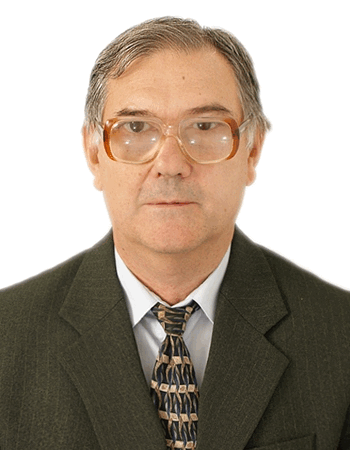
Head of Department – Alexander A. Ishchenko, Dr. Sci, Professor, Corresponding Member of the National Acаdemy of Sciences of Ukraine
The main research line of the department. The department is the world leader in the synthesis, study, and development of multifunctional photosensitive materials based on organic dyes, first and foremost, IR absorbers and emitters [1−11]. Polymethine dyes are the main object of study [1−6]. A diversity of synthetic methods have been elaborated to obtain dyes in various ionic states, namely, ionic (cationic [1,4], anionic [1,4,6,12,13], and cation-anionic [14,15]) and internal-ionic compounds (merocyanines [1,4,16,17], ketocyanines [18,19], mesoionic species [20], squaraines [21−24], croconines[21,24,25], and difluoroborate zwitterionic dyes [26−30]).
The most important scientific and practical achievements of the department. Aiming at higher stability of deeply coloured dyes, synthetic routes were developed to introduce bridge groups into the dye chromophore. The new methods were employed to synthesize stable dyes intensely absorbing light at wavelengths longer than 1200 nm [4], which was hitherto believed impossible. Also, the most long-wavelength π-π* absorption of known organics was obtained (1620 nm) [4].
Among the most important discoveries were the spectral deviation of unsymmetrical polymethines and the chromophore interaction in biscyanines [1]. The pioneering studies addressed the spatial structure of cyanines and the effect of the nature of their substituents as well as solvatochromism [1]. The novel classes of ketocyanines and polyones were investigated [18,19]. The dyes noted for their record large electronic asymmetry (with spectral maximum deviations over 500 nm) and Stokes shifts (Fig. 1) were synthesized [31]. The first organic dyes with conjugated cationic and anionic chromophores (Fig. 2) were prepared [32].

Fig. 1. Absorption and fluorescence spectra of the polymethine dye with a record large Stokes shift (in acetonitrile).
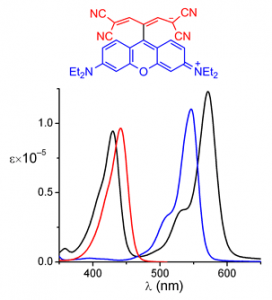
Fig. 2. Absorption spectra of the dye with conjugated cationic and anionic chromophores (see the black curve) and of its components (in ethanol).
Dyes of unusual structure derived from boron dipyrromethene and difluorodioxaborine [26−30] were found to have large two-photon absorption cross-sections and high fluorescence quantum yields at 700-900 nm [33,34]. A novel class of polymethine dyes containing carbocyclic instead of commonly used heterocyclic end groups was obtained and studied spectroscopically [12,13,23,24,35]. The first studies were conducted on the luminescence of polymethines [3,36] and the photonics of their ion pairs [37,38]. The electronic spectral band shapes of polymethine dyes were first analyzed [39,40] thus providing an insight into dye absorption selectivity and its relationship to the molecular structure [3,34,40]. A theoretical basis was developed to treat intermolecular interactions of cyanines in liquid solutions and polymer matrices [41−45]. The regularities which govern dye association including J-aggregation [49−52] were established [3,46−48]. The p-electron distribution in merocyanines was theoretically and experimentally investigated so as to control the dye electronic structure within the range of three ideal states (neutral polyene – polymethine – dipolar polyene) and also to govern the sign of solvatochromism (positive, negative, or inverse) by varying the donor-acceptor properties of end groups, the nature of solvent, and temperature [53−59] (Fig. 3).
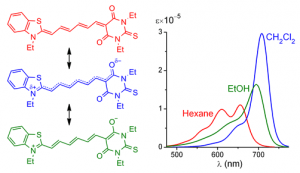
Fig. 3. Absorption spectra of the inverse solvatochromic merocyanine which can exist in any of three ideal states depending on medium polarity.
Juxtaposition of high-level quantum chemical data and a large body of experimental results afforded a qualitatively new understanding of the molecular electronic structure in the ground and excited states and enabled establishment of fundamental relationships between colour and luminescence of polymethines, on the one hand, and their constitution and the nature of the medium (e.g., solvent or polymer matrix), on the other hand. As a result, it became possible to purposefully prepare dyes with desired properties for diverse light-energy conversion applications. Some of the materials developed are mentioned below.
•Dye-based infra-chromatic photographic films [60] having much higher resolution and sensitivity than their analogues (including Kodak Aerographic Film 3432). They enable detection of hidden details behind the haze or under a coating and are employed to explore the earth surface and sea shelves, to assess the quality of cultivated areas and woodlands, and also to produce general- and special-purpose maps. The application of the I-1060B film is illustrated in Fig. 4.
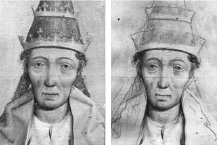
Fig. 4. A fragment of iconostasis of the 18th century (Tallinn): the image on the left was obtained on the KH-2 nano-chromatic film and the image on the right on the I-1060B infra-chromatic film.
• Novel classes of active laser media generating light at 600−900 nm which are based on unsymmetrical dyes with record broad absorption bands and record large Stokes shifts [31,61,62] (Fig. 1). These features allow the same dye to be used in various common laser pump sources (l = 308, 510, 532, 578, and 694 nm).
• A new polymer active medium which first provided tunable dye-laser generation with pumping at 1060 nm [63]. The conversion efficiency at wavelengths over 1100 nm amounts to 43% thus comparing well with the best active media for visible lasers.
• A passive Q-switch which first enabled passive mode locking of an erbium laser (lem = 1540 нм), a primarily important device in fiber optics, optical ranging, and ophthalmology [64] (Fig. 5).
• High-efficiency polymer passive Q-switches for nano- and picosecond solid-state lasers (lem = 694 [65], 1060 [66−68], and 1300 nm [69]) which have a long service life in the technology of “single pulse at the same point interval more times”.
• Dyed-polymer based absorption light filters protecting against laser radiation of 1060 nm wavelength [70]. They attenuate radiation by 4-6 orders of magnitude (as required), with 40−90% visual transmission, and can operate at any radiation incidence angle, in contrast to interference light filters.
• Dyes exhibiting a dramatic increase/decrease in dipole moment upon electronic excitation. A number of such compounds have been found to have pronounced nonlinear optical properties [33,34,71−74].
• New holographic recording media based on a dye-doped photothermoplastic polymer which are applied for nondestructive metal quality control [75,76]. Unlike many analogous materials, they need no photoprotection during latent image formation and can therefore be used under field conditions.
• Photovoltaic systems with the photosensitivityaround 700 nm (where the maximum solar photon flux occurs) employed in the fabrication of solar cells [77−79].
• Dyes for the compositions photopolymerized with a semiconductor laser (λem = 405, 650, 780, 830, 860, and 980 nm). A hitherto unknown effect of organic dyes has been revealed: Polymethine dyes initiate/inhibit methyl methacrylate thermal polymerization in the absence of a standard initiator [80].
• High-contrast fluorescent probes for medical and biological applications [81-83] (Fig. 6).
• Thiasquaraines exhibiting nearly 100% triplet quantum yield and hence efficiently sensitizing singlet oxygen formation [84].
![]()
• Chemosensors for food quality control.
• New selective chemosensors and labels for cations [85] and anions [86] derived from pyridine-2,6-dicarboxamides. Starting from them, a new receptor-ionophore system has been developed which contains multiple coordination centers in the molecule. Co2+, Zn2+, and Ni2+ ions complex with the pyridine moiety to cause a bathochromic absorption shift, whereas Pb2+, Hg2+, Cd2+,Mg2+, and Ca2+ ions form an aza-crown complex accompanied by a hypsochromic shift (Fig. 7).
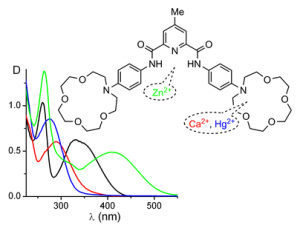
Fig. 7. Absorption spectra of the free and ion-bound (in the presence of Zn2+, Ca2+, and Hg2+ salts) ionophore.
•Dioxaborine dyes showing much promise as efficient luminescent indicators of primary and secondary aliphatic amines (Fig. 8), with a lower detection limit down to 1 µМ (1 ppm). As compared to Indophenol Blue, a well-known ammonia indicator, the dyes concerned are close in sensitivity being, moreover, much more time-saving, having a wider action range, and needing no special chemicals. They can be employed for ecological control in the amine industry.
1. A.I.Kiprianov, Colour and structure of cyanine dyes [in Russian]. – Kyiv: Naukova Dumka, 1979. 666 p.
2. A.D. Kachkovsky. Structure and colour of polymethine dyes [in Russian].– Kyiv: Naukova Dumka, 1989. 231 p.
3. O.O. Ishchenko, Structure and spectral luminescent properties of polymethine dyes [in Russian]. Kyiv: Naukova Dumka, 1994. – 232 с.
4. A.I. Tolmachev, Yu.L. Slominskii, A.A. Ishchenko. New cyanine dyes absorbing in the NIR region – In book: “New Infrared Dyes for High Technology Applications” NATO ASI Series.3. High Technology (Eds. S.Daehne, U.Resch-Genger and O.S.Wolfbeis). Dordrecht-Boston- London: Kluwer Academic Publishers. 1998. Vol.52. P.385-415.
5. A.I. Tolmachev, A.Ya. Il’chenko. Polymethine dyes // Kirk-Othmer Encyclopedia of Chemical Technology. – J. Wiley and Sons, Hoboken, US. – 2005. – Vol. 20. – P. 504-522.
6. A.Ilchenko. Organic dyes colour theory foundations [in Russian]. Kyiv: Naukova Dumka, 2012,264 p.
7. A.A. Ishchenko. Laser media based on polymethine dyes (reviews). – Quantum Electronics. – 1994. – Vol.24, No. 6. – P. 471-492.
8. A.A. Ishchenko. Physicochemical aspects of the creation of modern light-sensitive materials based on polymethine dyes (reviews). – Theoretical and Experimental Chemistry. – 1998. – Vol.34, N4. – P. 191-210.
9. A.A. Ishchenko. Molecular Engineering of Dye-doped Polymers for Optoelectronics. – Polym. Adv. Technol. – 2002. – Vol.13, No. 10-12. – P. 744-752.
10. N.A.Davidenko, O.O.Ishchenko, N.G.Kuvshinskii. Photonics of molecular semiconductor composites based on organic dyes. – Kyiv: Naukova Dumka, 2005. – 296 p.
11. Alexander Ishchenko. Photo-Converters Based on Dye-Doped Polymers. In book “Specialty Polymers. Materials and Applications” (Ed. Faiz Mohammad), I.K. International Publishing House Pvt. Ltd. New Delhi – Bangalore – Mumbai. – 2007. – P. 301 – 356.
12. I. V. Kurdyukova, N. A. Derevyanko, A. A. Ishchenko, and D. D. Mysyk.Deeply colored anionic polymethine dyes derived from bis(2,2,3,3,4,4,5,5-octafluoropentyl)-9H-fluorene-2,7-disulfonate. – Russian Chemical Bulletin. – 2009. – Vol. 58, No.4. – P. 828-837.
13. I. V. Kurdyukova, N. A. Derevyanko, A. A. Ishchenko, and D. D. Mysyk. Symmetric anionic polymethine dyes derived from fluorene and its derivatives with electron-acceptor substituents: synthesis and spectral properties. – Russian Chemical Bulletin. – 2012. – Vol. 61, No.2. – P.287-297.
14. A.A. Ishchenko, N.A. Derevyanko, S.V. Popov, Yu.L. Slominskil, V.L. Koval, S.A. Shapovalov, and N.O. Mchedlov-Petrosyan. Interaction of chromophores in dissimilar associates of cationic and anionic polymethine dyes in water. – Russian Chemical Bulletin. – 1997. – Vol. 46, N5. – P. 950-955.
15. M.I. Demchuk, A. A. Ishchenko, Zh.A. Krasnaya, V.P. Mikhailov. The excited-state relaxation times of cationic-anionic polymethine dyes. – Chem.Phys.Lett. – 1990. – Vol. 167, No.1,2. – P. 170-174.
16. A. V. Kulinich, and A.A.Ishchenko. Merocyanine dyes: synthesis. structure, properties, application (Review). Russian Chemical Reviews. – 2009. – Vol.78, No. 2. – P. 141 – 164.
17. I. V. Kurdyukova, A. A. Ishchenko, N. A. Derevyanko, and D. D. Mysyk. Synthesis and spectral properties of merocyanine dyes derived from tetranitrofluorene and heterocycles of various electron-donating ability. – Chemistry of Heterocyclic Compounds. – 2013. – Vol. 49, No. 2. – P. 281 – 293.
18. Yu.L.Slominskii, I.D.Radchenko, Condensation of dimethylidynehemicyanines with ketones. – Chem.Heterocycl. Comp. – 1974. – Vol. 10, No. 5.– P. 618-619.
19. G.G.Dyadyusha, A.A.Rykov, Yu.L.Slominskii, Stereoisomeric conversions of ketocyanine dyes. – Theor. Exp. Chem. – 1979. – Vol. 15, No. 1. – P. 51-55
20. A.I. Tolmachev, N.N. Romanov, K.V. Fedotov, G.G. Dyadyusha, A.D. Kachkovski. A study of the vinylene shifts in polymethine dyes with sulphur-containing end-groups. – Dyes and Pigments. – 1988. – Vol. 9, No 6. – P. 443-451.
21.A.I. Tolmachev and A.Ya. Il`chenko. Squarilium Dyes. – Sci. Appl. Photo. – 2001. – Vol. 42, №6. – P. 483-509.
22.A.I. Tolmachev, V.V. Kurdyukov, Yu.G. Vlasenko, and A.N. Chernega. Synthesis, Molecular, and Crystal Structure of 3,4-Bis[(2,6-di-tert-butyl-4H-pyran-4-ylidene)methyl]cyclobut-3-ene-1,2-dione and -1,2-Dithione. – Russian Journal of General Chemistry. – 2013. – Vol. 83, No. 11. – P. 2088–2094.
23. V.V. Kurdyukovand A.I. Tolmachev. Synthesis and spectral-luminiscence properties of a symmetrical squaraine – a benzoxazolium derivative. – Chemistry of Heterocyclic Compounds. – 2009. – Vol. 45, No. 10. – P. 1283-1284.
24.Irina V. Kurdiukova, Andrii V. Kulinich and Alexander A. Ishchenko. Near-infrared squarate and croconate dianions derived from tetranitrofluore. – New j. Chem. – 2012. – Vol. 34, No 8. – P. 1564 – 1567.
25. N.A. Davidenko, Yu.P. Get’manchuk, E.V. Mokrinskaya, L.N. Gumenyuk, V.A. Pavlov, N.G. Chuprina, N.N. Kuranda, S.V. Khutorny, A.A. Ishchenko, N.A. Derevenko, A.V. Kulinich, V.V. Kurdyukov, L.I. Kostenko. Croconium dye as a sensitizer of photothermoplastic holographic media for the near-IR region. – Journal of Optical Technology. – 2008. – Vol.75, No. 3. – P. 182 – 186.
26. K.V. Zyabrev, A.Ya. Il’chenko, Yu.L. Slominskii, N.N. Romanov, A.I. Tolmachev. Polymethine dyes derived from 2,2-difluoro-3,1,2(2H)oxaoxoniaboratines with polymethylene bridge groups in the chromophore. – Dyes & Pigments. – 2006. – № 71. – P. 199-206.
27. K. Zyabrev, A. Doroshenko, E. Mikitenko, Yu. Slominskii, A. Tolmachev. Design, synthesis, and spectral luminescent properties of a novel polycarbocyanine series based on the 2,2-difluoro-1,3,2-dioxaborine nucleus. – Eur. J. Org. Chem. – 2008. – № 9 – P. 1550-1558.
28. Yu.V. Zatsikha, V.P. Yakubovskyi, M.P. Shandura, I.Ya. Dubey, Yu.P. Kovtun. An efficient method of chemical modification of BODIPY core. – Tetrahedron. – 2013. – Vol. 69. – P. 2233-2238.
29. M.P. Shandura, V.P. Yakubovskyi, Yu.P. Kovtun. 3,5-Bis(acetaldehyde) substituted BODIPY. – Org. Biomol. Chem. – 2013. – Vol. 11. – P. 835-841.
30. M.P. Shandura, V.P. Yakubovskyi, A.O. Gerasov, O.D. Kachkovskyi, Ye.M. Poronik, Yu.P.Kovtun. α-Polymethinesubstituted boron dipyrromethenes – BODIPY-based NIR cyanine-like dyes. – Eur. J. Org. Chem. – 2012. – N 9. – P. 1825-1834.
31. N.A. Derevyanko, A.A. Ishchenko, Yu.L. Slominski, A.I. Tolmachev. First examples of dyes of the pyridopyrylo- and pyridopolycarbocyanine series: Synthesis and special spectral-luminescent properties. – Mendeleev Communications. – 1991. – N3. – P. 91-92.
32. M.P. Shandura, Ye.M. Poronik, Yu.P. Kovtun, A.A. Ishchenko. Substituted xanthylocyanines. IV. Trinuclear dyes with pyronine nucleus. – Dyes and Pigments. – 2008. – Vol.77, No.2. – P. 369 – 373.
33. L.A. Padilha, S. Webster, O.V. Przhonska, H. Honghua, D. Peceli, J.L. Rosch1, M.V. Bondar, A.O. Gerasov, Yu.P. Kovtun, M.P. Shandura, A.D. Kachkovski, D.J. Hagan, E.W. Van Stryland. Nonlinear absorption in a series of donor―p―acceptor cyanines with different conjugation lengths. – J. Mater. Chem. – 2009. – N19. – P. 7503–7513.
34. L.A. Padilha, S. Webster, O.V. Przhonska, H. Hu, D. Peceli, T. Ensley, M.V. Bondar, A.O. Gerasov, Yu.P. Kovtun, M.P. Shandura, A.D. Kachkovski, D.J. Hagan, E.W. Van Stryland. Efficient two-photon absorbing acceptor-π-acceptor polymethine dyes. – J. Phys. Chem. A –2010. – Vol. 114, No 23. – P. 6493–6501.
35. I.V. Kurdyukova, A.A. Ishchenko. Organic dyes based on fluorene and its derivatives. – Russian Chemical Reviews. – 2012. – Vol. 81, No. 3. – P. 258 – 290.
36. A.A. Ishchenko. Structure and spectral-luminescent properties of polymethine dyes (reviews). – Russian Chemical Reviews. – 1991. – Vol. 60, No. 8. – P. 865-884.
37. M.I. Demchuk, A.A. Ishchenko, V.P. Mikhailov, V.I. Avdeeva. The influence of the anion on the excited-state relaxation time of cationic polymethine dyes. – Chem.Phys.Lett. – 1988. – Vol. 144, No 1. – P. 99-103.
38. A.A. Ishchenko, N.A. Derevyanko and A.M. Vinogradov. Photoinduced Electron Transfer in Ion Pairs of Indotricarbocyanine Dyes. – Russian Journal of General Chemistry. – 1997. – Vol. 67, No 7. – P. 1122-1125.
39. G.G. Dyadyusha and A.A. Ishchenko. Application of the method of moments to the study of the electronic spectra of organic dyes. – Journal of Applied Spectroscopy. – 1979. – Vol.30, No 6. – P. 746 – 750.
40. A.A. Ishchenko. The nature of a heteroatom and spectral and luminescent properties of pyrylocyanine dyes. Optics and Spectroscopy. – 1994. – Vol. 77, №5. – P. 771-776.
41. A.A. Ishchenko, N.A.Derevyanko and A.I.Tolmachev. The unusual effect of solvent on the shape of the absorption bands of nonsymmetrical pyrylocyanine dyes. – Doklady Akademii Nauk SSSR. – 1984. – Vol. 271, N1. – P. 106 – 111.
42. A.A. Ishchenko, N.A. Derevyanko, V.M. Zubarovskii, A.I. Tolmachev. Influence of length of the polymethine chain on width of absorption bands of symmetric cyanine dyes. – Theoretical and Experimental Chemistry. – 1984. – Vol.20, N.4. – P. 415-422.
43. A.A. Ishchenko, V.A. Svidro and N.A. Derevyanko. Solvatofluorochromy of the cationic cyanine dyes. Dyes and Pigments. – 1989. – Vol. 10, N2. – P. 85-96.
44. A.A. Ishchenko. Photonics and molecular design of dye-doped polymers for modern light sensitive materials. – Pure and Appl. Chem. – 2008. – Vol. 80, No 7. – P. 1525 – 1538.
45. R. Reisfeld, A. Weiss, T. Saraidarov, E. Yariv and A.A. Ishchenko. Solid-state lasers based on inorganic–organic hybrid materials obtained by combined sol–gel polymer technology (Review). – Polym. Adv. Technol. – 2004. – Vol. 15, N 10-12. – P. 1-11.
46. A.A. Ishchenko, I.L. Mushkalo, N.A. Derevyanko, U. Zakhidov, T.S. Khidirova, N.Nizamov. Association of bis-cyanine dyes with rigidly connected chromophores in solvents of various polarity. – J. Inf. Rec. Mater. – 1989. – Vol. 17, No 1. – P. 39-51.
47. A.A. Ishchenko, F.G. Kramarenko, A.G. Maydannic, S.V. Sereda, N.P. Vasilenko. Structure and association of carbocyanines of the benz[c,d]indole series in binary mixtures of solvents. – J. Inf. Rec. Mater. – 1991. – Vol. 19, N3. – P. 207-219.
48. A.A. Ishchenko and S.A. Shapovalov. Heterogeneous association of the ions of dyes in solutions (Review). – Journal of Applied Spectroscopy. – 2004. – Vol. 71, No. 5. – P. 605 – 629.
49. Jakub Wenus, Samira Ceccarelli, David G. Lidzey, Alexei I. Tolmachev, Jurii L. Slominskii, Julia L. Bricks. Optical strong coupling in microcavities containing J-aggregates absorbing in near-infrared spectral range. – Organic Electronics. – 2007. – Vol.8, No2-3. – P. 120–126.
50. A.D.Nekrasov, B.I.Shapiro, A.I.Tolmachev, Yu.L.Slonimskii, V.A.Kuzmin, Effect of organic polyelectrolytes on H*-aggregation of meso-methyl-substituted thiacarbocyanine dyes. – High Energy Chem. –2011. – Vol. 45, No. 6. – P. 525-531.
51. B.I.Shapiro, E.S.Kol’tsova, A.G.Vitukhnovskii, D.A.Chubich, A.I.Tolmachev, Yu.L.Slominskii, Interaction between gold nanoparticle plasmons and aggregates of polymethine dyes: “Invisible” nanoparticles. –Nanotech.Russia. – 2011. –Vol. 6, No. 7-8. – P. 456-462.
52. B.I. Shapiro, L.S. Sokolova, V.A. Kuz’min, A.I. Tolmachev, Yu.L. Slominskii, and Yu.L. Briks. Effect of meso_Alkyl Substituents in the Polymethine Chain of Thiacarbocyanines on the Morphology of Dye Aggregates. – Nanotechnologies in Russia. – 2012. – Vol. 7, No. 5–6. – Р. 205–212.
53. A.A. Ishchenko, A.V. Kulinich, S.L. Bondarev, V.N. Knyukshto and A.A. Turban. Thermochromism and Thermofluorochromism of Merocyanines with a Positive Solvatochromism. – Optics and Spectroscopy. – 2006. – Vol. 101, No.1. – P. 90–97.
54. A.V. Kulinich, N.A. Derevyanko and A.A. Ishchenko. Electronic structure and solvatochromism of merocyanines based on N,N-diethylthiobarbituric acid. – J. Photochemistry and Photobiology A. – 2007. – Vol.188. – P.207 – 217.
55. A. V. Kulinich, A A. Ishchenko and U. M. Groth. Electronic structure and solvatochromism of merocyanines. NMR spectroscopic point of view. – Spectrochimica Acta. Part A. – 2007. – Vol. 68, N1. – P.6 – 14.
56. A.A. Ishchenko, A.V. Kulinich, S.L. Bondarev, and V.N. Knyukshto. Photodynamics of Polyene-Polymethine Transformations and Spectral Fluorescent Properties of Merocyanine Dyes. – J. Phys. Chem. A. – 2007. – Vol. 111, No. 51. – P. 13629-13637.
57. A.V. Kulinich, N.A. Derevyanko, A.A. Ishchenko, S.l. Bondarev, V.N. Knyukshto. Structure and fluorescent properties of merocyanines based on N,N-diethylthiobarbituric acid. – J. Photochemistry and Photobiology A. – 2008. – Vol. 197, No1. – P. 40 – 49.
58. A.V. Kulinich, N.A. Derevyanko, and A.A. Ishchenko. Synthesis and spectral properties of cyanine dyes – derivatives of 10,10-dimethyl-7,8,9,10-tetrahydro-6H-pyrido[1,2-a]indolium. – J. Photochemistry and Photobiology A. – 2008. – Vol. 198, No 2-3. – P. 119 – 125.
59. A.V. Kulinich, N.A. Derevyanko, A.A. Ishchenko, S.L. Bondarev, and V.N. Knyukshto. Structure and fluorescence properties of indole cyanine and merocyanine dyes with partially locked polymethyne chain. – J. Photochemistry and Photobiology A. – 2008. – Vol. 200, No 2-3. – P.106 – 113.
60. A.I. Tolmachev,Yu.L. Slominsky, B.I. Shapiro. Carbocyanine with the Ethylene and Vinylene Bridge Groups in the Chromophore. Synthesis, spectral and sensitizing properties. – Information Recording Materials. – 2003. – Vol.4, N3. – P. 3-8.
61. A.I. Tolmachev, Yu.L. Slominsky, B.I. Shapiro Carbocyanine with the Ethylene and Vinylene Bridge Groups in the Chromophore. Synthesis, spectral and sensitizing properties. – Information Recording Materials. – 2003. – V. 4, No 3. – P. 3-8.
62. V.A. Svetlichny, O.K. Bazyl, E.R. Kashapova, N.A. Derevyanko, and A.A. Ishchenko. Influence 0f Absorption from excited singlet states on the lasing parameters of polymethine dyes. Quantum Electronics. – 2009. – Vol. 39, No 8. – P. 739 – 744.
63. V.I. Bezrodnyi, A.A. Ishchenko. High efficiency lasing of the dye-doped polymer laser with 1.06 mm pumping. – Appl. Phys. B. – 2001. – Vol. 73, No. 3. – P. 283 – 285.
64. N.A. Derevyanko, A.A. Ishchenko, I.G. Kuchma, A.A. Mak, A.G. Murzin, E.G. Pivinsky, D.S. Prilezhaev, Yu.L. Slominsky, Z.A. Smirnova, A.I. Tolmachev, V.A. Fromzel’. Fast-Relaxating Passive Switch Based on Polymethine Dyes for Erbium Laser with 1.54 μm Wavelength. – Optics and Spectroscopy. – 1989. – Vol. 67, No 4. – P. 920 – 926.
65. V.I. Bezrodnyi, N.A. Derevyanko, A.A. Ishchenko. High efficient polymer passive switches for a ruby laser. – Quantum Electronics. – 1996. – Vol. 26, No 4. – P. 345-347.
66. V.I. Bezrodnyi, A.A. Ishchenko, L.V. Karabanova, Yu.L. Slominskii. Highly stable polymethine-dye-based polymer switches for passive mode locking in neodymium laser. – Quantum Electronics. – 1995. – Vol. 25, No 8. – P. 819-822.
67. R. Grigonis, M. Eidenas, V. Sirutkaitis, V. Bezrodnyi. A. Ishchenko, Yu. Slominskii. Relaxation times of new passive polymer switches for 1.06 mm. – Ultrafast Processes in Spectroscopy. – 1996. – P. 449-453.
68. V.I. Bezrodnyi, A.A. Ishchenko. High-energy single pulse and multispike operation with a passive polymer Q-switch. – Optics and Laser Technology. – 2002. – Vol. 34, No 1. – P. 7-13.
69. V.I. Bezrodnyi, N.A. Derevyanko, A.A. Ishchenko, Yu.L. Slominskii. Polymer passive laser switches for stimulated emission in the region of 1.3 mm. – Quantum Electronics. – 1995. –Vol. 25, No 8. – P. 823-825.
70. V.I. Bezrodnyi, N.A. Derevyanko, A.A. Ishchenko, L.V. Karabanova, T.A. Plisko, Yu.L. Slominskii, A.L. Smirnova. Absorption filters based on polymethine dyes for protection from laser radiation with a wavelength of 1060 nm. – J. Optical Technology. – 1996. – Vol. 63, No 12. – P. 936 – 940.
71. R.A. Ganeev, R.I. Tugushev, A.A. Ishchenko, N.A. Derevyanko, A.I. Ryasnyansky, T. Usmanov. Characterization of nonlinear optical parameters of polymethine dyes. – Appl. Phys. B. – 2003. – Vol. 76. – P. 683-686.
72. S.L. Bondarev, S.A. Tikhomirov, V.N. Knyukshto, A.A. Turban, A.A. Ishchenko, A.V. Kulinich and Isabelle Ledoux. – Fluorescence and solvatochromism of a merocyanine dye
with a high quadratic polarizability in solutions and polymer films. – Journal of Luminescence. –2007. –Vol. 124, No 1. – P. 178 – 186.
73. V.A. Svetlichnyi, A.A. Ishchenko, E.A. Vaitulevich, N.A. Derevyanko, A.V. Kulinich. Nonlinear optical characteristics and lasing ability of merocyanine dyes having different solvatochromic behaviour. – Optics Communication. – 2008. – Vol. 281. – P. 6072 – 6079.
74. Andrii V. Kulinich, Nadia A. Derevyanko, Elena K. Mikitenko, Alexander A. Ishchenko. Merocyanines based on 1,3-indanedione: electronic structure and solvatochromism. – J. of Physical Organic Chemistry. – 2011. – Vol. 24, No 8. – P. 732 – 742.
75. Nikolay Davidenko, Irina Davidenko, Alexandr Ishchenko, Andrey Kulinich, Valeriy Pavlov, Sergey Studzinsky, and Nikolay Chuprina. Reversible holographic recording media based on polymeric composites and their use in energy-saving technologies. – Applied Optics. –2012. – Vol. 51, No 10. – P. C49 – C54.
76. Pat. No. 100823 (Ukraine). IPC G 03H 1/18. Optical medium for optical hologram recording / N.A.Davidenko, Yu.P.Hetmanchuk, O.V.Mokrynska, A.A.Ishchenko, N.A.Derevianko, S.Ya.Studzinskii, N.G.Chuprina, A.V.Kulinich // Industrial property [in Ukraine]. – 2013. – № 2.
77. Ya. Vertsimakha, A. Verbitsky, A. Ishchenko, N. Derevyanko. Photovoltaic properties of photosensitive in wide spectral region heterostructures. – In book “Moleular Low Dimensional and Nanostructured Materials for Advanced Applications” (Eds A. Graja et al.). – Amsterdam, Kluwer Academic Publishers. – 2002. – P. 311-314.
78. Ya. Vertsimakha, A. Verbitsky, A. Ishchenko, V. Syromyatnikov, I. Pomaz. Effect of polymer molecular structure on photosensitivity of composites films based on infra-red polymethine dye. – Molecular Crystals and Liquid Crystals. – 2011. – Vol. 536. – P. 99(331) – 106(338).
79. Valery N. Bliznyuk, Jacek Gasiorowski, Alexander A. Ishchenko, Gennadiy V. Bulavko, Nadezhda A. Derevyanko, Niyazi Serdar Sariciftci.Photoresistance and photo induced current hysteresis in bulk heterojunction systems P3HT–PCBM–polymethine dye. – Organic Electronics. – 2014. – Vol. 15, No 6. – P. 1105–1112.
80. G.P. Grabchuk, A.Yu. Kolendo, N.A. Derevyanko, and A.A. Ishchenko. Effect of Polymethine Dyes with Various Electron-Donating Abilities of Terminal Groups on hermopolymerization of Methylmethacrylate in Solutions. – Molecular Crystals and Liquid Crystals. – 2008. – Vol. 497. – P. 76(408) – 83(415).
81. US2010041045 (A1) Nucleic acid fluorescent stains/ Rueck Alexander; Schoenenberger Bernhard; Yarmoluk Sergiy; Kovalska Vladyslava; Losytskyy Mykhaylo; Slominskii Yurii ― Pub.date 2010-02-18.
82. 8th Siena Meeting 2008 “From Genome to Proteome: Integration and Proteome completion”. – Siena, Italy, 2008, August 31st – September 4th.
83. A.S. Tatikolov, I.G. Panova, A.A. Ishchenko, and M.A. Kudinova. Spectral and Fluorescent Study of the Interaction of Squarylium Dyes, Derivatives of 3H_Indolium, with Albumins. –Biophysics. – 2010. – Vol. 55, No 1. – P. 35–40.
84. Davorin Peceli, Honghua Hu, Dmitry A. Fishman, Scott Webster, Olga V. Przhonska, Vladimir V. Kurdyukov, Yurii L. Slominsky, Alexey I. Tolmachev, Alexey D. Kachkovski, Andrey O. Gerasov, Artëm E. Masunov, David J. Hagan, and Eric W. Van Stryland. Enhanced Intersystem Crossing Rate in Polymethine-Like Molecules: Sulfur-Containing Squaraines versus Oxygen-Containing Analogues. – J. Phys. Chem. A. – 2013. – Vol. 117. – P. 2333−2346.
85. J.L. Bricks, G. Reck, K. Rurack, B. Schulz, M. Spieles. Cation Coordination of Bisamidopyridine-derived Receptors as Investigated in the Solid-state and in Solution. –Supramolecular Chemistry. – 2003. – Vol. 15. – P. 189-197.
86. Anton Kovalchuk, Julia L. Bricks, Günter Reck, Knut Rurack, Burkhard Schulz, Agnieszka Szumna, Hardy Weißhoff. A charge transfer-type fluorescent molecular sensor that “lights up” in the visible upon hydrogen bond-assisted complexation of anions. – Chem. Commun . – 2004. – P. 1946 – 1947.
87. M.P. Shandura, Yu.P. Kovtun, V.P. Yakubovskyi, Yu.P. Piryatinski, P.M. Lutsyk, R.J. Perminov, A.B. Verbitsky, A. Rozhin. Dehydroacetic acid based dioxaborine styryl dye: effective fluorescent probe for ammonia and amine detection. – Key Engineering Materials. –2014. – Vol. 605. – P. 159-162.

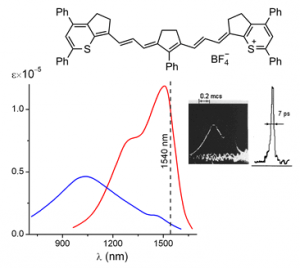
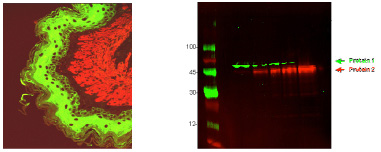
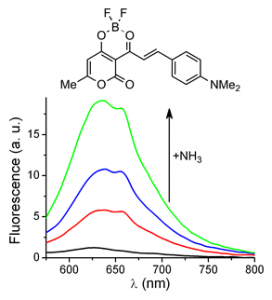
Leave a Reply
You must be logged in to post a comment.